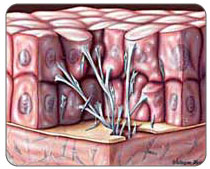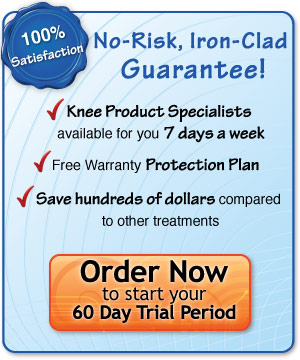 | What Are Trigger Points?Symptoms of Knee Trigger Point PainThe trigger point spot will usually become more tender or sting when you push on the spot and the referred pain will increase in intensity. Other symptoms include:
Causes of Trigger Point Pain in the Knee AreaTender trigger points typically develop from lack of stretching or improper stretching and can also be caused from stress/trauma, overexertion, poor conditioning, or overuse of a muscle. Trigger point pain in the knee and upper thigh is commonly caused by:
Reduced circulation in trigger points will eventually lead to muscle shortening and restricted movement which further accentuates the pain, thus completing a cycle of decreased mobility and further pain. This commonly becomes the underlying cause of chronic knee and thigh pain, and the patient will continue to suffer from these until the problem trigger points are treated directly. Mild Trigger Points can be addressed sometimes through massage and some sufferers maintain that acupuncture treats these problems as well, though it is not accepted by many medical institutions. Treating Trigger Point Knee Pain!If you have knee and/or thigh pain caused by tense, constricted muscles use a TShellz Wrap® for your trigger points. Trigger point pain is caused by constricted muscle fibers that form knots, and eventually cause a buildup of toxins in the area. The trick to getting rid of this pain is loosening the knots to release the constricted muscle fibers. This will allow blood to flow through the fibers once again, bringing the vital oxygen and nutrients required for healthy tissue. An effective and pain-free way to loosen the knots is via Circulation Boost through use of a TShellz Wrap.  In addition, you want to get your muscle tissue back in the best possible condition you can. To do this, it is important to treat the scar tissue that forms in the muscle when the damaged tissue begins to heal - something the TShellz Wrap® is also great at! Even with optimum healing, there is always less elasticity in previously injured muscles fibers. However, use of conservative treatment options such as the TShellz Wrap® and a stretching routine to treat scar tissue build up, your chance of chronic trigger point pain and knee conditions later on should be reduced substantially. Scar tissue can also bind muscle fibers together. The inflexible scar tissue limits the movement of your muscles that were once elastic leaving your tissue weaker than a healthy muscle and at greater risk of deterioration and possible tearing. Fortunately, you can treat your pain and trigger points with the TShellz Wrap® device which helps release muscle knots, soften scar tissue, relax tense muscles, relieve muscle spasm, and improve the motion and flexibility of the knee and thigh. Once the inflammation of your trigger points has been reduced, nourishing and strengthening soft tissue is recommended. Using a TShellz Wrap® will greatly boost blood flow in the area, giving your body the ability to heal your muscle more completely preparing it for strengthening exercises. Talk to your doctor or physical therapist to find out which exercises are appropriate for your situation. TShellz Wrap® & Circulation BoostAfter severe inflammation and swelling is reduced you can begin to treat your tendons and muscles with Circulation Boost (Circulatory Boost). Circulatory Boost increases the amount of blood that flows naturally to your muscles to nourish your soft tissue to speed healing. Devices that stimulate blood flow can help treat muscle trigger point pain and accelerate the bodys' healing process so you can get back to living. Circulation Boost, via use of a TShellz Wrap® will help loosen knots at the trigger points, improve elasticiy of the soft tissue (and help minimize scar tissue growth), and promote blood flow to loosen your constricted muscles and other soft tissue. Your muscles naturally receive a limited blood supply and when you stop moving your leg and knee because of pain the blood flow is reduced even further, limiting your body's natural ability to heal itself. By treating yourself with a TShellz Wrap® you can increase your body's blood supply to the muscles, thereby increasing your bodys own natural healing power. A TShellz Wrap® is the tool you need to treat your sore knee and trigger points because it and relaxes muscles, and accelerates blood flow in the area, helping clear out toxins from the trigger point area. With Circulatory Boost, tissues are safely and gently stimulated. Your body responds with a rapid increase in blood flow to the area, increasing the supply of oxygen and nutrients to injured tissue to promote healing. Our Leg/Arm TShellz Wrap® provides effective, non-invasive, non-addictive pain relief with no side effects. The Leg/Arm TShellz Wrap® is so versatile you can use it to treat your thigh muscles, knee, and practically anywhere else you are experiencing pain and soft tissue damage. Why does the improved blood flow whisks away dead tissue and toxins that have built up from your trigger point pain? When you stop moving your sore leg and knee, your muscles and other tissue can become weaker and dead tissue and toxins in the area can cause further tissue deterioration - this can lead to atrophy (muscle weakness and/or deterioration). A device that stimulates blood flow will clear the area of toxins while increasing the amount of oxygen and nutrients to your soft tissue. Because of this, the risk of atrophy is greatly reduced as well, allowing you to retain and even improve movement and flexibility. Keeping your thigh and knee tissue as healthy as possible throughout the healing process will allow you to improve leg and joint strength again once your pain has gone and your trigger point pain has healed. With these easy therapies - cold therapy and the TShellz Wrap® Circulatory Boost device, you will notice significantly reduced pain and an incredible improvement in your range of motion. The more diligent you are with your treatment and rehabilitation, the faster you will see successful results! If you suffer from trigger points, we guarantee this solution for you - or your money back! Product Advisors are available 9:00 am to 5:00 pm Eastern Standard Time Monday to Friday. Learn More About Knee Injuries & TreatmentsI want to learn more about post-surgery recovery. I want to learn all about common causes of knee pain. I want to learn more about TShellz Wrap® Circulatory Boost I want to learn more about Ice & Heat: Which Is Better For Treatment? I want to learn more about Knee Treatments. I want to learn more about Runners Knee. I want to learn more about Hoffas Syndrome. I want to learn more about Knee Arthritis. I want to learn more about Knee Trigger Points. FREE SHIPPING ON ALL PRODUCTS CURRENTLY ENABLED |
      |

